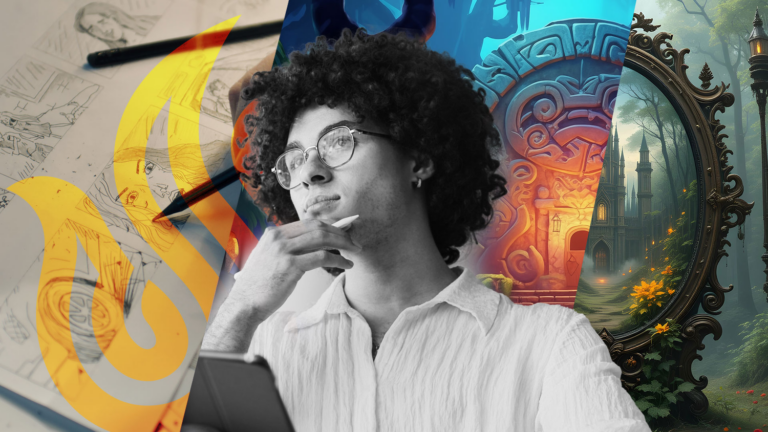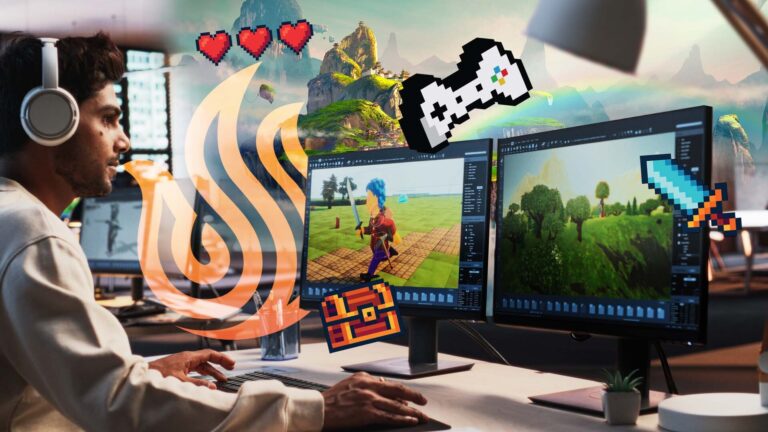If you are wondering whether to become a 3D modeler or an animator, it may surprise you to learn that most artists in either field learn both disciplines. In a professional setting, these two archetypes work closely with one another to determine if creative ideas are feasible. However, don’t be discouraged if you had your heart set on one or the other role. If you like one, you’ll enjoy the other by virtue of how similar each discipline is.
What is 3D Modeling?
3D modeling is the process of creating objects and characters in a digital space. You can think of it as a form of digital sculpting. Artists who specialize in 3D models spend many hours perfecting the intricate details of each object. The process is very similar to how statues and other figures are created in real life. The key difference being that you use software instead of physical tools. After completing a model, it can be rendered into a scene.
3D models are used in nearly all forms of modern entertainment. From TV, to movies, video games, and even in online video content. A skilled artist can represent anything with 3D models.
3D modelers often have an animation background as well. Once an object’s appearance is finalized, it still requires movement to make its presence believable in the fabricated world.
How is 3D Modeling Used in Animation?
3D modeling is an important part of animation because the movement of each object is determined by the inner working of the model itself. The best example of this is in characters such as humans and animals. Each living being needs a complex rig that simulates the bone and muscle structure of their body. 3D modeling helps to create realistic internal structures that allow for fluid movement externally.
Everyone knows how a human is supposed to look when they walk. You have seen the leg muscles of millions of people who are engaged in this activity. Animation on mundane objects and characters isn’t believable unless it follows the logical expectations of the audience. This requires a pretty accurate character rig to pull off. There is much more leeway in fantasy creatures and exotic animals. Since audiences are less familiar with how these beings move, animators and modelers can take additional artistic liberties when bringing those characters to life.
Animators don’t always have dedicated 3D modelers backing them up. In these cases, it is vital that an animator know how to make basic changes to each model as needed. Certain movements require additional tweaking to the rig. Likewise, a proficient 3D modeler will learn as much about animation as possible in case the shoe is on the other foot. You can work much more efficiently in either field when you have a good understanding of both.
How Can I Become an Animator Who Specializes in 3D Modeling?
There are two primary options for pursuing a career in digital arts. There is some overlap in knowledge in each field of animation and 3D modeling. You can choose to surf the web and teach yourself or you can enroll in a dedicated digital arts program specializing in 3D art or animation. Each option provides a different chance of success when applying for your first job within the industry.
Self-study
In the age of YouTube tutorials and how-to articles, it can be tempting to just learn everything online. While this may work for most small tasks, some things are too important to take such a haphazard approach with. The quality of information varies on the Internet. For every nugget of truth you find, you will need to sift through tons of outdated or flat-out incorrect information. This may not seem like a big deal at first, but this can cause unforeseen damage to your career down the line.
Learning bad habits and outdated information can be worse than starting from scratch. For a company to introduce you to their workflow, they will first need to break those bad habits. Your previous bad experience will conflict with the proper procedures of a professional studio. While you are not expected to know everything on day one, it is rough when you show up to your new job with a slew of bad habits that need to be squelched.
Attend a Creative Arts College with a Program in 3D Modeling
The option that affords you more opportunities is to enroll in a digital arts program with a focus on 3D animation or modeling. Either one will suffice since the information overlap makes it easy to cover both disciplines. These programs typically touch on the other digital arts topics such as film production and game design. You get a little bit of everything, which is extremely helpful for career variety down the road. There are tons of benefits to enrolling in formal classes instead of scouring the Internet for good tutorials. Here are some of the most crucial advantages you can look forward to.
Benefit #1: Experienced Instructors and Up-To-Date Information
The credentials of online content creators can be extremely difficult to verify. If you want to learn a career-starting skill, then you want to make sure you are being taught by qualified instructors. Creative arts colleges employ teachers with experience that have worked on projects that were released to the public. You can rest assured they know what they are talking about during their lectures.
Not only can you ask these instructors all the questions you want about the industry, but the instructors will originate ideas and concepts you haven’t even considered. Getting insider information about your field makes it easier to land your first job. You will know what employers are looking for since your instructors are tapped into the studios that are likely to hire you. Having an up-to-date understanding of how to present yourself during job interviews is priceless.
Benefit #2: A Chance to Use Professional Equipment and Software
Both the hardware and software used at a professional level are out of the price range of most individual users working out of a home studio. The advanced rigs needed to produce modern content is breathtaking. Many large projects require servers to keep everything organized. On the software side, the professional version of most apps has a hefty fee. A creative arts college allows you to explore what the pros use without breaking the bank.
Although there are a lot of free software alternatives, having familiarity with the same tools used by the studio that hires you is a massive advantage. Being knowledgeable on your first day will leave a great initial impression on your team.
Benefit #3 Developing a Network of Like-Minded Artists
Arguably, the best part of attending a creative arts college is the networking opportunities. Every artist you befriend can potentially lead to future job offers. You never know when someone’s company will need a spot filled quickly. The more friends you have in the industry, the more chances you have to be in the right places at the right times. There are few places better to meet like-minded artists and build a network than a digital arts campus.
What Do You Learn During a 3D Modeling Program?
There are many topics to cover in a 3D modeling and animation program. Overall, you will learn how to bring 3D spaces to life. No matter who you work for, the goal will always be to breathe energy into the fabricated worlds you oversee. Before hopping into the digital landscape, you will spend some time studying classic art. An understanding of how traditional art manifests in the real world is crucial to making the worlds you work on believable. Even the smallest details can throw an audience off since everyone has seen examples of classical forms all around them. You must become intimately familiar with the core concepts of art before recreating it in a digital environment.
Use Professional Animation Tools
You start off in the digital workstation by recreating existing objects from a selection of prefabs. This allows you to build familiarity with the tools you will be using every day. After you are comfortable recreating previous work, you will begin to design objects in your own style. As the curriculum advances, you will get a chance to make entire scenes. This requires character rigging and basic animation training. You will gradually develop the characters that fill the world you create by learning how to produce believable movement on a multitude of different objects.
Learn Teamwork
Throughout the entire program, teamwork is emphasized at each step of the creative process. Modern animated projects are worked on by groups of well over a hundred people. Social skills are nearly as important as the technical talent you develop. Clear communication and conflict resolution are the name of the game. You can’t allow the inevitable small disputes to disrupt the rest of the team.
Create a Portfolio
Finally, you will start compiling a portfolio in the second half of your program. A portfolio displays all your finest work to potential employers. Artists typically use portfolios instead of a resume when seeking employment. The experienced instructors can give you valuable insight into how to set up a personal portfolio website. Once you have an eye-pleasing portfolio website, you are all set to land your first position after graduation.
Final Thoughts
The art of both 3D modeling and animation goes hand-in-hand. The best way to break into the industry is to attend a creative arts college program that focuses on both subjects. You get a great overview of other digital mediums while acquiring a thorough grasp on both animating and modeling 3D objects. Couple that with the advice of experienced instructors and a network of befriended artists, and you will have everything you need to land a job once you graduate. The market for both animators and modelers is booming, as more and more people continue to turn to digital sources of entertainment in record numbers.
Now that you know how 3D modeling is used in animation, want to learn more? University of Silicon Valley’s 3D Modeling concentration has been designed to ensure Digital Arts & Animation degree program students get the most relevant training and access to modern industry tools taught by subject matter experts. You’ll learn professional workflows and create your own 3D models for films, video games and more.
University of Silicon Valley is uniquely poised to offer a meaningful and valuable education for 21st century students. We believe in an education that directly correlates with the work you’ll be doing after you graduate. Interested in learning more? Contact Us today.


